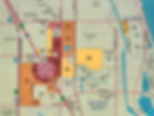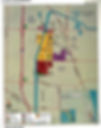The MacArthur land sale: Development unleashed 25 years ago
- pbghistory
- Feb 18, 2024
- 4 min read

In 1999, Palm Beach Gardens faced a cataclysmic event: The sudden surge of highly developable land entering the market after two decades of slow growth orchestrated by the John D. and Catherine T. MacArthur Foundation.
In May 1998, the Chicago-based foundation decided to pull out of the local land market. It would sell all of its Florida property, nearly 15,000 across several counties, to the highest bidder.
The foundation selloff included more than 4,000 acres in Palm Beach Gardens. It would create a land rush the likes never before or since seen in the city.
How the city dealt with the crush of new development is the subject of the Palm Beach Gardens Historical Society’s second panel discussion to commemorate the city’s 65th anniversary. The free and open forum is at 6:30 p.m. Thursday Feb. 22 at Palm Beach State College’s Meldon Hall in Building BB on the PGA Boulevard campus.
The panelists all played major roles: then-Mayor Joe Russo, then-city planner Marty Minor and then-Catalfumo Development executive Joey Eichner. The panel’s moderator, then-City Councilman Eric Jablin, is a historical society board member.
Thousands of residents now live in the developments that resulted from the MacArthur Foundation selloff. It came 20 years after the death of the foundation’s namesake, city founder John D. MacArthur, and 40 years after the city’s founding.
The date of March 31, 2024, will mark exactly 25 years since the real estate deal closed.
Some of the names of places involved in the deal in which people live and play now but were not imagined then:
Old Palm Golf Club and Bent Tree along Central Boulevard.
The Hamptons at Hood Road.
Frenchman’s Reserve on Alternate A1A at Hood.
Paloma and The Isles flanking Military Trail.
Evergreene and Magnolia Bay, also along the Trail.
San Michele and the Benjamin Upper School along Central.
The four corners of A1A and PGA Boulevard: Downtown at the Gardens, Legacy Place, the FPL office site and PGA Station.

Who bought the land?
In late 1998, a company called Watermark Communities Inc., headed by Al Hoffman, outbid Florida land giant St. Joe Co.’s Peter Rummell for the MacArthur land.
Hoffman did so by ignoring the rules of the land sale, a fact both Hoffman and Rummell discussed at a Miami conference in April 1999, after the deal had closed.
“Al Hoffman is a very smart man,” Rummel said, as quoted in The Palm Beach Post. “The foundation, as you know, puts out all of these elaborate rules (cash up front, no financing), and we stupidly paid attention to the rules. He was smart enough to say that was an interesting starting point, but who cares?”
Hoffman replied: “The only real difference between him and me is, I bid more money.”
Hoffman offered two prices: $220 million cash or $260 million with a $40 million deposit and time to raise the rest. He ended up paying $228 million, property records showed. He also benefited because the MacArthur Foundation owned 17 percent of his company.
St. Joe bid $185 million cash.

Builders ready to build
By buying time, Hoffman forged a sweet deal for WCI. He had engineered $130 million in land sales to a half-dozen big investors, which closed in March 1999. In the next few months he sold another $50 million worth of land.
On paper, WCI paid MacArthur $119.5 million on March 31, 1999.
But in reality, WCI bought for itself a manageable 6,000 acres for $48 million, including prime land west of Florida’s Turnpike and north of Indiantown Road, while cashing out $180 million.
Here’s a rundown of what happened to the land WCI sold off:
Commercial builder Dan Catalfumo paid $41 million for the land that would become Downtown at the Gardens, Legacy Place, PGA Station and the FPL site. Later, he paid $10 million more for land next to the Gardens Mall.
DiVosta & Co. paid $35 million for 610 acres that became The Isles and Magnolia Bay.
Toll Brothers spent $25 million on 430 acres that became Frenchman’s Reserve.
Shopping center builder Centrefund Realty paid $6.1 million for 45 acres at the southwest corner of Donald Ross Road and Military.
Frankel Enterprises paid $3.2 million for 65 acres, to become the 91 homes of San Michele.
John C. Bills Enterprises paid $2.6 million for 632 acres, some of which he sold to the government for preservation.
The Benjamin School bought 50 acres for $2.5 million.
Other buyers who came in later that year included Terrabrook for land on Military Trail in Jupiter, Westport Holdings for what is now La Posada next to the Gardens Mall and the Palm Beach Community Church, which bought the land that today is Midtown northwest of PGA and Military.
But what happened when all those builders began knocking on the city’s door, asking the city’s small planning department to review their developments?
The City Council applied the brakes. They forced the developers to proceed one by one and they demanded lower density to keep from overwhelming city roads and services.
To read a March 18, 1999, letter from Al Hoffman to Mayor Joe Russo detailing the developers' approach, click here.
To read the Forbearance Agreement that the City Council approved to slow the development blitz, click here.
This historical moment is based on reporting in The Palm Beach Post by Joel Engelhardt and Ava Van de Water in 1998 and 1999.
You can watch the society's first panel discussion focusing on "How the MacArthur Foundation shaped Palm Beach Gardens, 1978 to 1998," by clicking here.
— Joel Engelhardt
Full pages from the Portfolio maps, courtesy of Marty Minor at Urban Design Studio, are below. And an invitation to the Feb. 22 panel discussion.
To see the actual portfolio documents, never before made public, click on the name below:





